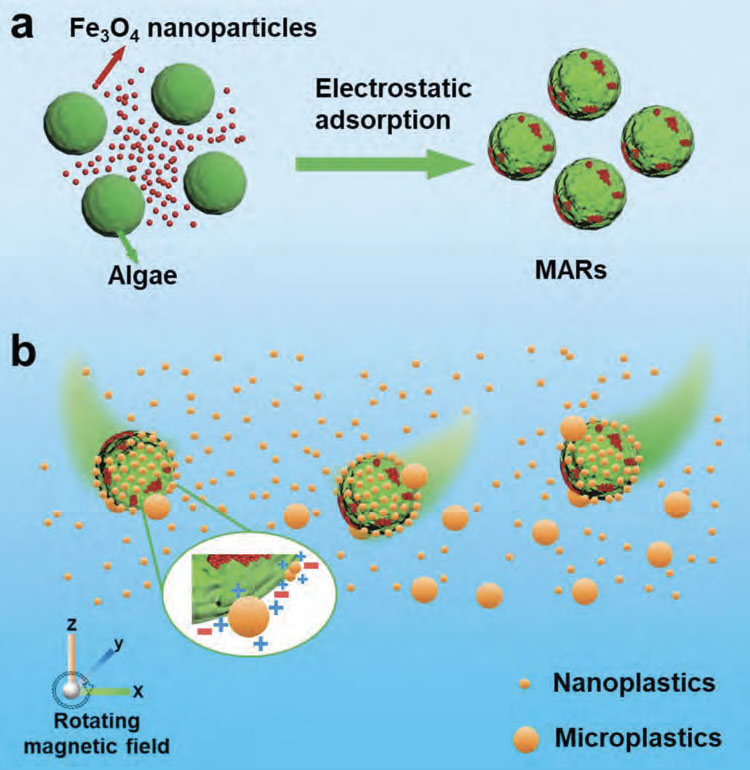| Oct 25, 2023 | |
Microalgae robots capture plastic pollution in water |
|
| (Nanowerk Spotlight) Plastic waste is increasingly polluting our oceans and waterways. As plastics break down in the environment, they fragment into tiny pieces known as microplastics and nanoplastics. Microplastics are plastic particles under 5 mm in size, while nanoplastics are smaller than 1 micron. These minuscule plastic fragments come from the degradation of larger plastic products, as well as from microbeads and fibers shed during washing of synthetic textiles. | |
| Their tiny size allows microplastics and nanoplastics to easily enter food chains. Aquatic organisms may ingest them, resulting in digestive issues or false feelings of satiation that can lead to starvation. The large surface area of microplastics also allows them to absorb toxins and chemicals from the environment. These harmful compounds can bioaccumulate up the food web, eventually reaching humans who consume seafood. | |
| Microplastics and nanoplastics suspended in water are difficult to remove using conventional methods like filtration. Their small size allows them to simply pass through conventional filter pores and gaps. New solutions are needed to actively seek out and capture plastic particles from contaminated sites. | |
| Now researchers have devised an eco-friendly solution - microscopic robots made from algae cells that can actively seek out and capture plastic particles when controlled by magnetic fields. | |
| In a new study published in Advanced Functional Materials ("Biohybrid Magnetically Driven Microrobots for Sustainable Removal of Micro/Nanoplastics from the Aquatic Environment"), scientists from the Czech Republic decorated live microalgae with magnetic nanoparticles to create controllable “microalgae robots” (MARs). | |
 |
|
| Biohybrid MARs for effective removal of micro/nanoplastics from water. a) Bare algae cells integrated Fe3O4 nanoparticles on the surface via electrostatic absorption. b) Utilizing magnetic actuation and electrostatic interactions, MARs facilitate the removal of micro/nanoplastics from water by drawing them to their surface. (Image: Reprinted with permission by Wiley-VCH Verlag) | |
| Algae cells were chosen as the structural basis for the MARs because of their natural negative surface charge, which makes them interact electrostatically with positively charged plastics. By attaching positively charged iron oxide nanoparticles to the outside of the algae, the researchers were able to steer and control the MARs via rotating magnetic fields, allowing precision direction of the robots to actively hunt down microplastic prey. | |
| The MARs were able to capture both polystyrene microplastics and nanoparticles with over 90% efficiency through combined electromagnetic attraction and precise locomotion. Their tiny bio-robotic size allows them to take advantage of small electrostatic forces to latch onto even nanoscale plastic litter as they swim past under magnetic direction. In contrast, previous microplastic-catching robots made from inorganic materials often rely on less efficient passive Brownian motion. | |
| Another key advantage of the MARs is that they are made of naturally occurring and biodegradable biological materials, avoiding expensive or toxic components. Conventional microrobotics often require rare elements like gold or platinum for fabrication. The algae-based MARs can also self-replicate, allowing easy, low-cost scaling of the technology. | |
| Tests showed the MARs experience minimal toxicity from the iron oxide nanoparticle “cores” and can even exhibit increased replication with low concentrations of nanoparticles - a phenomenon called hormesis. The nanoparticles also stayed attached to the algae during plastic capture, preventing secondary nano-contamination of the environment. | |
| After collecting microplastics and nanoplastics, the team was able to magnetically separate the MARs and release the plastic particles for disposal. The MARs could be reused for at least 5 repeated capture cycles with little loss of efficiency. When tested in real environmental waters like tap water and lake water rather than just pure lab samples, the algae robots still performed well above 80% removal efficiency. | |
| “The introduced biohybrid microrobots, originating from naturally existing microalgae integrated with magnetic iron oxide nanoparticles, hold considerable promise for addressing environmental challenges associated with micro/nanoplastics in a sustainable and cost-effective manner,” concluded the researchers. | |
| The work demonstrates a new “green” approach to environmental microrobotics using only biodegradable materials derived from living organisms. While still in early stages, microalgae-based plastic hunters could offer a scalable solution for reducing microplastic pollution in waterways and oceans. Strategies for collecting the MARs after use in open environments could be a next step toward real-world deployment. With further development, miniaturized teams of algae-bots may one day provide a self-replicating method for actively targeting plastic waste in water and removing it magnetically for proper disposal. | |
 By
Michael
Berger
– Michael is author of three books by the Royal Society of Chemistry:
Nano-Society: Pushing the Boundaries of Technology,
Nanotechnology: The Future is Tiny, and
Nanoengineering: The Skills and Tools Making Technology Invisible
Copyright ©
Nanowerk LLC
By
Michael
Berger
– Michael is author of three books by the Royal Society of Chemistry:
Nano-Society: Pushing the Boundaries of Technology,
Nanotechnology: The Future is Tiny, and
Nanoengineering: The Skills and Tools Making Technology Invisible
Copyright ©
Nanowerk LLC
|
|
|
Become a Spotlight guest author! Join our large and growing group of guest contributors. Have you just published a scientific paper or have other exciting developments to share with the nanotechnology community? Here is how to publish on nanowerk.com. |
|
